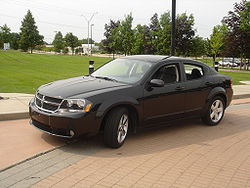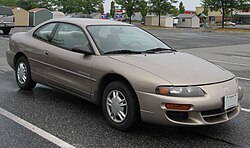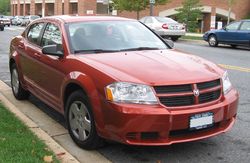Dodge Avenger
| Dodge Avenger | |
|---|---|
 | |
| Overview | |
| Manufacturer | Mitsubishi Motors (1995-2000) Chrysler Group (2008-) |
| Production | 1995-2000 2008- |
| Body and chassis | |
| Class | Mid-size |
| First generation | |
|---|---|
 | |
| Overview | |
| Production | 1995–2000 |
| Assembly | Normal, Illinois |
| Body and chassis | |
| Body style | 2-door coupe |
| Layout | FF layout |
| Platform | Chrysler FJ platform |
| Related | Chrysler Sebring (coupe) Eagle Talon Mitsubishi Eclipse Mitsubishi Galant |
| Powertrain | |
| Engine | 2.0 L 420A I4 2.5 L Mitsubishi 6G73 V6 |
| Transmission | 5-speed
manual 4-speed 41TE automatic |
| Dimensions | |
| Wheelbase | 103.7 in |
| Length | 190.2 in (1998-2000) 187.2 in (1995-97) |
| Width | 69.1 in (1998-2000) 68.5 in (1995-97) |
| Height | 53.0 in (1998-2000) 51 in (1995-97) |
| Chronology | |
| Predecessor | Dodge Daytona Dodge Stealth |
| Successor | Dodge Stratus coupe (for 2001) |
| Second generation | |
|---|---|
 | |
| Overview | |
| Production | 2008- |
| Assembly | Sterling Heights, Michigan |
| Designer | Ryan Nagode, Graduate of the Cleveland Institute of Art, Industrial Design Program 2003 |
| Body and chassis | |
| Body style | 4-door sedan |
| Layout | Front engine, front-wheel drive / four-wheel drive |
| Related | Mitsubishi Lancer Mitsubishi Outlander Chrysler Sebring Dodge Caliber Jeep Compass Jeep Patriot Dodge Journey |
| Powertrain | |
| Engine | 2.4 L GEMA I4 2.7 L EER V6 3.5 L EGJ V6 2.0 L TDI I4 |
| Transmission | 4-speed 40TES automatic 4-speed 41TES automatic 6-speed 62TE automatic |
| Dimensions | |
| Wheelbase | 108.9 in |
| Length | 190.9 in |
| Width | 71.8 in |
| Height | 58.9 in |
| Chronology | |
| Predecessor | Dodge Stratus |
Introduced as a 1995 model year vehicle the Dodge Avenger was a rebodied Mitsubishi Eclipse. Not especially quick even in that time, it was exceptional when it came to handling. One major thing was due to the design it could fit four average sized adults in relative comfort. This model was discontinued after the 2000 model year.
In 2005 rumours started to spread that the Avenger name would be returning to the Dodge lineup though this time it would be replacing the Dodge Stratus, the coupe version of which replaced the Avenger in 2001. This time however it would not be a coupe but a sedan only. The car was officially unveiled at the Frankfurt Auto Show. That model had a diesel engine, but is currently only available in the US and Canada with a choice of three gasoline engines. The diesel is available in other international markets.
The Dodge Avenger is actually three different cars:
- The Dodge Avenger coupe (1995-2000)
- The Dodge Avenger Concept from the 2003 North American International Auto Show
- The Dodge Avenger (JS) sedan released in 2007 for the 2008 model year.
The name Avenger was originally used on the Hillman Avenger (later Chrysler/Talbot Avenger), produced by Rootes Group while that company was owned by the Chrysler Corporation.
First generation (1995-2000)
The first generation Dodge Avenger was a 2-door coupe produced from 1995 to 2000, replacing the Dodge Daytona and the Mitsubishi-based Dodge Stealth (which was discontinued in 1996). The Avenger, along with the similar Chrysler Sebring coupe, were built by Diamond Star Motors (DSM), a joint venture between Chrysler Corporation and Mitsubishi Motors, on a stretched version of the Mitsubishi Eclipse platform. This joint venture between the two ended in 1995. Avengers and Sebring coupes built from 1995 to 1996 both have DSM markings in their engine compartments.
The Avenger had a 103 in (2.62 m) wheelbase and used either a 2.0 L I4 (the Chrysler 420A) or a Mitsubishi-designed 2.5 L V6. The 4-cylinder was coupled to either a five-speed manual transmission, shared with the Mitsubishi Eclipse and Eagle Talon, or a 4-speed automatic. The V6 was only available with the A604 transmission, and cannot be swapped out easily due to a lack of transmissions that can fit around the front axle. The easiest way to swap out the automatic transmission on this car is an entire drivetrain swap.
The Avenger and Eagle Talon/ Mitsubishi Eclipse both share quite a number of parts, including much of their suspension components and interior (namely their dashes). While said to be built on a "stretched" Talon/Eclipse platform (which is not entirely untrue), it is more accurate to say that its platform more similar to that of Mitsubishi’s Galant.
Changes
Very subtle changes were made to the Avenger over the years. ABS was equipped in all ES models to 1999. In 1997, the front fascia, trunklid, and rear bumper were changed; 16 inch wheels were standard, and the license plate was moved to the rear bumper. In 2000, the V6 and automatic transmission combo was made standard on all Avengers, and ABS was made an "option" for ES models. The four-cylinder engine was also dropped for 2000.
Trims
- 1995-2000 - base (V6 among other options made standard in 2000)
- 1995-2000 - ES
A "Sport Appearance Package" could be added on to Base model cars. This package included alloy wheels (different from those on the ES), among other options.
Timeline
1994: A 1994 Dodge NASCAR IROC Dodge Avenger sports coupe replaced the Dodge Daytona, which had been used since 1990. Only 6 of these were sold from IROC in New Jersey. [1] [2]
1995: Initial introduction - replaces the Daytona. A DOHC 16-valve 2.0 L I4 engine (140 hp, 130 lb-ft of torque) is standard. A SOHC 24-valve 2.5 L V6 engine and an automatic transmission (155 hp, 160 lb-ft of torque) are made optional on the ES. Fog lamps and ABS are also optional on the ES.
1996: Power and torque ratings for the V6 are increased (163 horsepower, 170 lb.-ft. torque), ES Coupes wore new seat fabric. Dodge Stealth is discontinued (Only 50-some TTs made), the 3000GT continues.
1997: Sport model introduced (in addition to the base and ES). The Avenger Sport package consisted of exclusive 16 inch aluminum wheels and a body-color spoiler. New front and rear fascias are added. Added a body-color rear spoiler, P215/50HR17 tires and 17 inch cast aluminum wheels for are added for the ES. The V6 is also made standard for the ES, as well as rear disc brakes.
1998: An on-board recycling vapor recovery system, Caffe Latte exterior color and a black and gray interior color combination are added.
1999: Next generation driver and front passenger airbags are added, as well as a new exterior color; Shark Blue. The V6 engine and automatic transmission are made standard on all models in mid-year, as well as several options.
2000: Last year for the Avenger. V6/automatic drivetrain are standard. ABS an option on ES models. Gained a number of standard features that had previously been optional, including power windows and locks. Base models added cruise control, and 4-wheel disc brakes. ES coupes now came with standard leather upholstery, keyless remote entry, and a power driver's seat.
In 2000 the Avenger was discontinued, and replaced by the Dodge Stratus coupe for 2001.
Second generation (2008-)
The Avenger has returned for 2008 as a sedan to replace the aging Dodge Stratus, whose coupe version had replaced the original Avenger in 2001. The Avenger, along with the redesigned Chrysler Sebring, shares a DaimlerChrysler/Mitsubishi Motors platform called the GS. For the new cars, the GS platform is stretched in size and known as the JS. The base engine in the SE and SXT trim levels is the 2.4 LGEMA I4 naturally-aspirated "World Engine", a joint venture between DaimlerChrysler, Mitsubishi and Hyundai. Additional engines include an optional 2.7 L V6 in the SXT and a standard 3.5 L V6 in the R/T trim level. The new Avenger is expected to be sold worldwide. In addition to the 2.4 L "World Engine" and the V6s, export vehicles will be offered with the 2.0 L naturally-aspirated "World Engine", as well as a 2.0 L turbocharged diesel (Pumpe-Düse) made by Volkswagen [3]. As a 2008 model, the Dodge Avenger came to showrooms in February 2007. [4]
The Avenger will replace the Charger as Dodge's car in NASCAR in 2007 for Car of Tomorrow races.
The vehicle was officially unveiled at the Paris Motor Show on September 28, 2006 as a concept car.
Trims
The Avenger is currently one of only a handful of midsized automobiles for sale in Canada and the US available with AWD and a 6spd transmission.
SE: 2.4L 4 Cyl DOHC 16V Dual VVT 4 spd automatic
SXT: 2.4L 4 Cyl DOHC 16V Dual VVT 4 spd automatic SXT optional powertrain: 2.7L V6 DOHC 24 Valve MPI 4 spd automatic
R/T: 3.5L High Output V6 24V MPI 6spd automatic
R/T AWD: 3.5L High Output V6 24V MPI 6 spd automatic
Trivia
- The first generation Dodge Avenger body style was widely used in the National Hot Rod Association, but came to the most prominence being driven by Darrel Alderman, and Scott Geoffrion, during their run from 1994 -2000, as the celebrated Dodge Boys.
